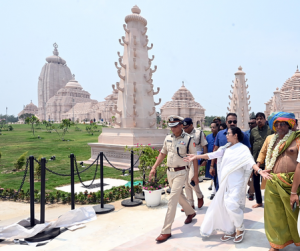‘Dham’ signage removed from Digha Jagannath temple site amid row

Kolkata: Amid controversies on whether the Lord Jagannath Temple at Digha in the East Midnapore district of West Bengal can be described as “Dham”, the signage of “Jagannath Dham” has been removed from the site of the said temple.
Local Trinamool Congress legislator Akhil Giri had claimed that the illuminated signage was a temporary structure that was raised for the purpose of the inauguration of the temple on April 30.
“The signage has been removed after the inauguration. There is no other reason behind this development. Construction of a new gate of the temple named after Chaitanya Mahaprabhu is going on. The signage might be raised again after that,” Giri said.
However, Leader of the Opposition in the West Bengal Assembly had claimed that the signage was removed after two controversies over the Digha structure, the first in relation to the structure being described as a “Dham” and the second being charges of leftover timber meant for Puri’s Jagannath Temple being used to carve deities in Digha.
He claimed that the signage removal happened after it was clear that the adoption of unethical means to create a perception of equivalence between Puri and Digha had failed, and those behind such attempts started feeling the heat.
Since the beginning, multiple controversies have surfaced over the Digha temple.
The first controversy was in relation to why the Digha Temple was referred to as ‘Jagannath Dham Cultural Centre’ as recorded by the implementation agency of the temple, the West Bengal Housing Infrastructure Development Corporation (WBHIDCO).
Legal brains felt that this was done deliberately to avoid controversies as regards constitutional obligations on spending public money from the state exchequer to construct or develop any religious structure.
Then surfaced the controversy over naming the Digha structure as Jagannath Dham Cultural Centre, ignoring the significance of the word “Dham”.
As per traditional Hindu belief, there are four Dhams, popularly known as “Char Dham”, namely Badrinath, Dwarka, Rameswaram, and Puri.
Apart from that, no other temple or religious establishment can be referred to as a Dham since the word has a special religious significance.
IANS
News